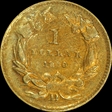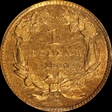Branch Mint Gold Dollars 的展示图片库
Since the open wreath variety of this coin is exceeding rare with only 5 known coins, the closed wreath is the only collectable variety for this date. This piece has the typical convex looking obverse and a reverse with a weakly struck date. A small tic in the obverse field is the only detraction on this green gold first year issue.
Since the open wreath variety of this coin is exceeding rare with only 5 known coins, the closed wreath is the only collectable variety for this date. This piece has the typical convex looking obverse and a reverse with a weakly struck date. A small tic in the obverse field is the only detraction on this green gold first year issue.
Since the open wreath variety of this coin is exceeding rare with only 5 known coins, the closed wreath is the only collectable variety for this date. This piece has the typical convex looking obverse and a reverse with a weakly struck date. A small tic in the obverse field is the only detraction on this green gold first year issue.
The most common of the Dahlonega gold dollars and very popular with type collectors. Deeply and irredescently toned obverse and reverse. A spectacular example.
The most common of the Dahlonega gold dollars and very popular with type collectors. Deeply and irredescently toned obverse and reverse. A spectacular example.
The most common of the Dahlonega gold dollars and very popular with type collectors. Deeply and irredescently toned obverse and reverse. A spectacular example.
The most common of the Dahlonega gold dollars and very popular with type collectors. Deeply and irredescently toned obverse and reverse. A spectacular example.
The first gold dollar from this mint has the open reverse. Dusty antique gold surfaces with nice strike with slight wear on the curls of the hair. Coppery accents the peripheral devices. Small "0" mint mark.
The first gold dollar from this mint has the open reverse. Dusty antique gold surfaces with nice strike with slight wear on the curls of the hair. Coppery accents the peripheral devices. Small "0" mint mark.
One of the rarest Charlotte gold dollars with only the excessively rare 1849 open wreath and the 1859 with less mintage. This piece has pleasing green-gold coloration with splashes of russet at the perimeter and traces of blue on Liberty's coronet and reverse lettering. Very well struck for this issue with the exception of a weak "c" mintmark. The smooth almost defect free surfaces add to the overwhelming eye appeal.
One of the rarest Charlotte gold dollars with only the excessively rare 1849 open wreath and the 1859 with less mintage. This piece has pleasing green-gold coloration with splashes of russet at the perimeter and traces of blue on Liberty's coronet and reverse lettering. Very well struck for this issue with the exception of a weak "c" mintmark. The smooth almost defect free surfaces add to the overwhelming eye appeal.
The rarest gold dollar for this mint. Yellowish-gold toning on obverse with nice coppery overtones on the reverse. Strong strike and so close to mint state.
The rarest gold dollar for this mint. Yellowish-gold toning on obverse with nice coppery overtones on the reverse. Strong strike and so close to mint state.
The California Gold rush and private minters like the Betchler's pressured Congress to adopt a new denomination, the gold dollar. The gold dollar was first produced in 1849 at all four mints, Philadelphia, New Orleans, Dahlonega, and Charlotte. This coin minted at the Charlotte Mint has beautiful golden toning and nice strike.
The California Gold rush and private minters like the Betchler's pressured Congress to adopt a new denomination, the gold dollar. The gold dollar was first produced in 1849 at all four mints, Philadelphia, New Orleans, Dahlonega, and Charlotte. This coin minted at the Charlotte Mint has beautiful golden toning and nice strike.
Mintage: 9,982. Liberty Coronet. First minted in 1849, at 13mm this is the smallest of all United States coins. A conditionaly rare issue in AU55 with a total coins known in all grades of 150-175. This example has green-gold, crusty surfaces and splashes of gold toning. Some die clashing evident on reverse. One of the few U. S. issues with the date on the reverse.
Mintage: 9,982. Liberty Coronet. First minted in 1849, at 13mm this is the smallest of all United States coins. A conditionaly rare issue in AU55 with a total coins known in all grades of 150-175. This example has green-gold, crusty surfaces and splashes of gold toning. Some die clashing evident on reverse. One of the few U. S. issues with the date on the reverse.
One of the commoner New Orleans gold dollars this example has nice original golden color with darker toning nearer the rims. Bold strike and luster as so close to mint state.
One of the commoner New Orleans gold dollars this example has nice original golden color with darker toning nearer the rims. Bold strike and luster as so close to mint state.
The 1852-c gold dollar is one of the two most common from this mint but is much harder to locate than its counterpart the 1851-c. Most 52-c dollars are seen in EF45-AU53 grades and nice AU specimens with natural color and surfaces are difficult to locate. This very pleasing slider example shows natural deep green-gold toning on obverse and reverse. The flatness of strike and some cabinet friction on this piece has limited the grade to AU58. On the reverse there is a mint-made planchet depression through the LA of Dollar. (per Douglas Winter)
The 1852-c gold dollar is one of the two most common from this mint but is much harder to locate than its counterpart the 1851-c. Most 52-c dollars are seen in EF45-AU53 grades and nice AU specimens with natural color and surfaces are difficult to locate. This very pleasing slider example shows natural deep green-gold toning on obverse and reverse. The flatness of strike and some cabinet friction on this piece has limited the grade to AU58. On the reverse there is a mint-made planchet depression through the LA of Dollar. (per Douglas Winter)
The 1852-c gold dollar is one of the two most common from this mint but is much harder to locate than its counterpart the 1851-c. Most 52-c dollars are seen in EF45-AU53 grades and nice AU specimens with natural color and surfaces are difficult to locate. This very pleasing slider example shows natural deep green-gold toning on obverse and reverse. The flatness of strike and some cabinet friction on this piece has limited the grade to AU58. On the reverse there is a mint-made planchet depression through the LA of Dollar. (per Douglas Winter)
The 1852-c gold dollar is one of the two most common from this mint but is much harder to locate than its counterpart the 1851-c. Most 52-c dollars are seen in EF45-AU53 grades and nice AU specimens with natural color and surfaces are difficult to locate. This very pleasing slider example shows natural deep green-gold toning on obverse and reverse. The flatness of strike and some cabinet friction on this piece has limited the grade to AU58. On the reverse there is a mint-made planchet depression through the LA of Dollar. (per Douglas Winter)
Uncountalbe clashmarks to the left of Lady Liberty gives her a "broken nose" look. Original yellow gold and good strike withstanding, this issue is degraded by poor lustre and clashmarks. Very difficult to find nice looking 52-D'S
Nice golden toning with only slight wear on the hair above the ear and the "1" on the reverse. Stars and all devices boldly struck. A rare Dahlonega type one gold dollar
This date seems to have many coins with contact marks, dings, and mint made problems. The present piece is no exception as it has a number of dings and contact marks on the obverse, but a nice strike. The reverse has die scratches but otherwise has good strike and decent luster.
The first gold dollar struck at the newly open San Francisco Mint. Reddish golden toning enhances the near wear free surfaces of the only type one coin from this mint. "One Dollar" is weakly struck.
The 1855-C is numismatically significant as the only Type Two gold dollar from the Charlotte mint. It is also one of only two one-year types from this mint along with the 1839-C half eagle. The 55-C gold dollar is seen most often in EF40 to AU50 and properly graded AU53 coins are scarce. This example is better struck than usual and is found on an above-average quality planchet. As with many examples, there are clashmarks and some areas of roughness but the natural green-gold surfaces are more solid and eye appealing than usual for the issue. The date and mintmark are bold and the borders show nearly full detail. (per Doug Winter)
The 1855-C is numismatically significant as the only Type Two gold dollar from the Charlotte mint. It is also one of only two one-year types from this mint along with the 1839-C half eagle. The 55-C gold dollar is seen most often in EF40 to AU50 and properly graded AU53 coins are scarce. This example is better struck than usual and is found on an above-average quality planchet. As with many examples, there are clashmarks and some areas of roughness but the natural green-gold surfaces are more solid and eye appealing than usual for the issue. The date and mintmark are bold and the borders show nearly full detail. (per Doug Winter)
Mintage: 1,811. Indian Princess. Complaints that the gold dollar was too small caused a redesign in 1854. A collosal mistake of design by James Longacre with weak strikes of virtually all coins from all five mints. This issue has a weak 8 in the date, as with most 55's, otherwise nice detail and gold toning with some reflectiveness noted around the devices. As attractive as a 55-D can get. The rarest of all Dahlonega gold dollars. From the North Georgia Collection.
Mintage: 1,811. Indian Princess. Complaints that the gold dollar was too small caused a redesign in 1854. A collosal mistake of design by James Longacre with weak strikes of virtually all coins from all five mints. This issue has a weak 8 in the date, as with most 55's, otherwise nice detail and gold toning with some reflectiveness noted around the devices. As attractive as a 55-D can get. The rarest of all Dahlonega gold dollars. From the North Georgia Collection.
The most available Type II branch mint dollar. It is also the best made of the branch issues with good strikes and detail with exception to the 8 in the date. This particular specimen has a nice strike and detail with a strong date. Some slight reflective areas also are evident. The Type II design was abandoned after less than three years of use due to poor strikes. Most of the coins' dates wore off rapidly and were sent to the mint for melting resulting in very few coins remaining.
The most available Type II branch mint dollar. It is also the best made of the branch issues with good strikes and detail with exception to the 8 in the date. This particular specimen has a nice strike and detail with a strong date. Some slight reflective areas also are evident. The Type II design was abandoned after less than three years of use due to poor strikes. Most of the coins' dates wore off rapidly and were sent to the mint for melting resulting in very few coins remaining.
The 56-D creation is the third rarest coin behind the 55-D and 61-D. This piece has smooth overall wear with nice gold toning. The U in United is weak, as usual, but the date is complete with slight weakness. Eye appeal can be difficult with the issue but is nice for this specimen.
The 56-D creation is the third rarest coin behind the 55-D and 61-D. This piece has smooth overall wear with nice gold toning. The U in United is weak, as usual, but the date is complete with slight weakness. Eye appeal can be difficult with the issue but is nice for this specimen.
The redesign of the gold dollar did little to improve the quality of the 1857 issue as it is one of the poorest manufactured coins ever issued by a U. S mint. Most specimens are made with inferior dies and badly produced planchets. Virtually all examples exhibit weak, incomplete strikes with flat to little lustre. The present example is one of the better produced coins with a fairly good strike with some lustre enhanced by golden toning in the fields. This is about as attractive as this issues gets, which isn't saying much.
The redesign of the gold dollar did little to improve the quality of the 1857 issue as it is one of the poorest manufactured coins ever issued by a U. S mint. Most specimens are made with inferior dies and badly produced planchets. Virtually all examples exhibit weak, incomplete strikes with flat to little lustre. The present example is one of the better produced coins with a fairly good strike with some lustre enhanced by golden toning in the fields. This is about as attractive as this issues gets, which isn't saying much.
The redesign of the gold dollar did little to improve the quality of the 1857 issue as it is one of the poorest manufactured coins ever issued by a U. S mint. Most specimens are made with inferior dies and badly produced planchets. Virtually all examples exhibit weak, incomplete strikes with flat to little lustre. The present example is one of the better produced coins with a fairly good strike with some lustre enhanced by golden toning in the fields. This is about as attractive as this issues gets, which isn't saying much.
1858-D G$1 MS61 PCGS. Variety 10-M. A single die pair is known for the scant mintage of 3,477 pieces. The present example has peach-gold toning around design elements while the high points and open fields are gunmetal-blue. No marks are visible, though a J-shaped strike-though, as made and often seen on the issue, is near the ED in UNITED. The strike is above average for a Dahlonega emission, with blending evident on the 5 in the date and the leaf above the right ribbon end. The reverse displays a triple set of clash marks from Liberty's profile
1858-D G$1 MS61 PCGS. Variety 10-M. A single die pair is known for the scant mintage of 3,477 pieces. The present example has peach-gold toning around design elements while the high points and open fields are gunmetal-blue. No marks are visible, though a J-shaped strike-though, as made and often seen on the issue, is near the ED in UNITED. The strike is above average for a Dahlonega emission, with blending evident on the 5 in the date and the leaf above the right ribbon end. The reverse displays a triple set of clash marks from Liberty's profile
1858-D G$1 MS61 PCGS. Variety 10-M. A single die pair is known for the scant mintage of 3,477 pieces. The present example has peach-gold toning around design elements while the high points and open fields are gunmetal-blue. No marks are visible, though a J-shaped strike-though, as made and often seen on the issue, is near the ED in UNITED. The strike is above average for a Dahlonega emission, with blending evident on the 5 in the date and the leaf above the right ribbon end. The reverse displays a triple set of clash marks from Liberty's profile
The 1859-C is the last gold dollar produced at the Charlotte Mint. It is also a candidate for the poorest made U.S. coin. Virtually all coins have inferior planchets, bad strikes, clashmarks, and other mintmade imperfections. Of the 3000 coins made virtually all possess less than average eye appeal. This representatives' eye appeal is about as good as it gets for this issue.
The 1859-C is the last gold dollar produced at the Charlotte Mint. It is also a candidate for the poorest made U.S. coin. Virtually all coins have inferior planchets, bad strikes, clashmarks, and other mintmade imperfections. Of the 3000 coins made virtually all possess less than average eye appeal. This representatives' eye appeal is about as good as it gets for this issue.
Mintage: 4,952. Indian Princess (Large Head) The design blunder by Longacre brought about the immediate redesign of the gold dollar once again in 1856. An improvement, but incomplete strikes still evident at branch mints. This example has bright yellow golden toning with only trace of wear. Near full strike, nice frosty luster, and eye appeal. A rare issue in AU58. Total coins known 150-175.
Mintage: 4,952. Indian Princess (Large Head) The design blunder by Longacre brought about the immediate redesign of the gold dollar once again in 1856. An improvement, but incomplete strikes still evident at branch mints. This example has bright yellow golden toning with only trace of wear. Near full strike, nice frosty luster, and eye appeal. A rare issue in AU58. Total coins known 150-175.
The gold CAC sticker carried on this first generation PCGS holder is suggestive of a higher grade than the XL40 indicated. The coin has beautiful original copper coloration on both obverse and reverse as well as a pretty decent strike for this issue. With a mintage of less than 2000 it is one of the rarest gold dollar made.
The gold CAC sticker carried on this first generation PCGS holder is suggestive of a higher grade than the XL40 indicated. The coin has beautiful original copper coloration on both obverse and reverse as well as a pretty decent strike for this issue. With a mintage of less than 2000 it is one of the rarest gold dollar made.
The gold CAC sticker carried on this first generation PCGS holder is suggestive of a higher grade than the XL40 indicated. The coin has beautiful original copper coloration on both obverse and reverse as well as a pretty decent strike for this issue. With a mintage of less than 2000 it is one of the rarest gold dollar made.
Only 13,000 examples of this date were struck making the 1860-S gold dollar scarce and undervalued in all grades. This lustrous piece has splashes of golden color atop the surfaces, is well struck and appealing for the grade.
Only 13,000 examples of this date were struck making the 1860-S gold dollar scarce and undervalued in all grades. This lustrous piece has splashes of golden color atop the surfaces, is well struck and appealing for the grade.




















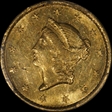
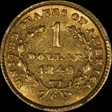
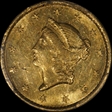
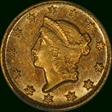

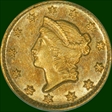
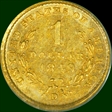
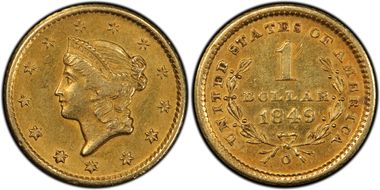
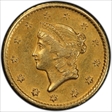
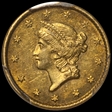



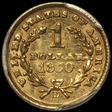

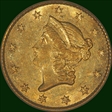
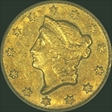
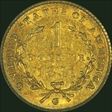


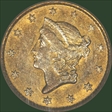
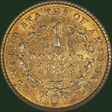

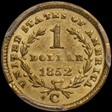

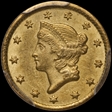

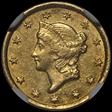
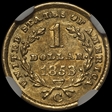
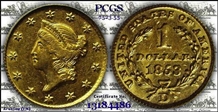
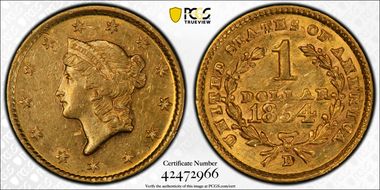

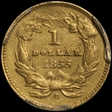
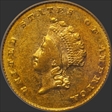
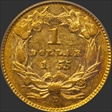
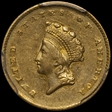
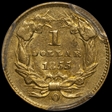
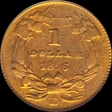
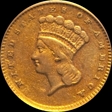


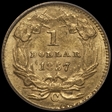
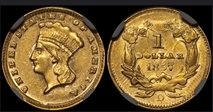
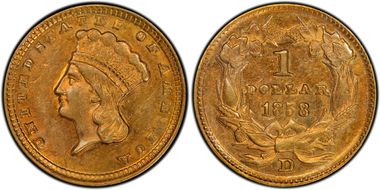

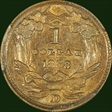
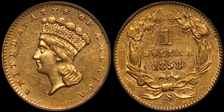

_album.jpg)




